Folder Tidy User Guide
How to Organize Messy Folders
Folder Tidy is designed to organize files in a folder into neatly categorized subfolders. For instance, a cluttered Desktop can be tidied by moving all images into an Images folder, spreadsheets into a Spreadsheets folder, and more. Folder Tidy utilizes 20 built-in rules as well as custom rules based on powerful predicates to efficiently sort your files.
Requires macOS 10.13 or higher
Supported macOS versions:
macOS 10.13 High Sierra - macOS 14 Sonoma
Latest Version:
Folder Tidy 2.9.4
Release Date:
June 19, 2024
Pricing (USD):
One time purchase of $5USD (50% off), with no subscription.
Save 50% - was $10.
One-time payment.
Table of Contents
Getting Started
Running a tidy requires three main steps. Each step is explained in detail below the screenshot, which shows what the app looks like when it is first opened.

Step 2: The next action is to choose which folder will store the sorted files. It can also be any folder as long as the logged in user on the Mac has permissions to write to it. Choosing is exactly the same as in the previous step. This will be known as the "destination folder".
Step 3: The final step is to decide which options to use for the tidy. By default it will not move files inside of subfolders and will have most of the built-in rules enabled. To allow it to recursively search through more than one level of folders, click the "Include files inside subfolders" checkbox.
To access more options like this, click the "More options" link.
App settings
To access the settings, either click the Folder Tidy application menu and choose "Settings…" or "Preferences…" depending on which macOS version is being used, or click the "More options" link in the main window.
General options
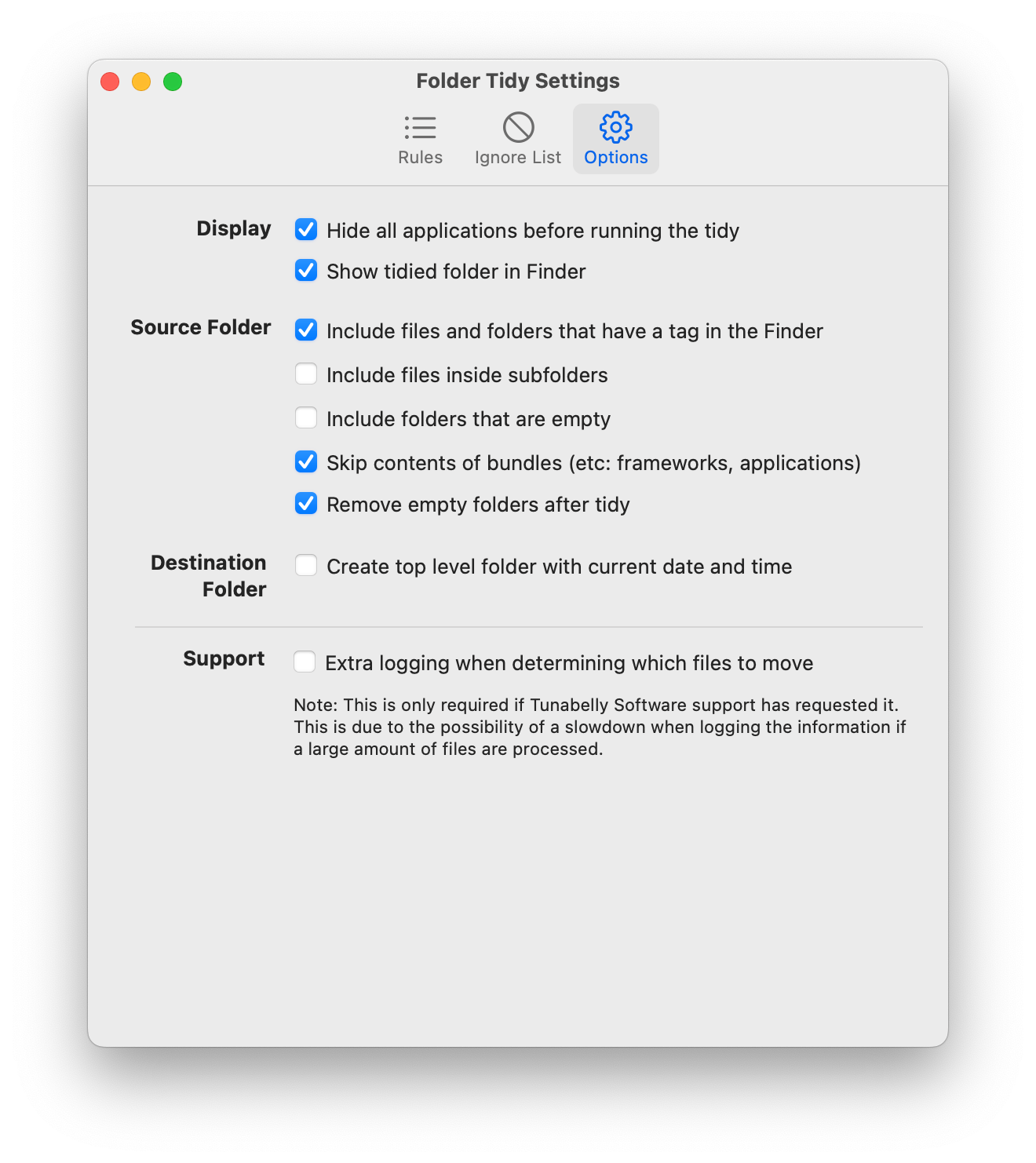
Here's what each option does in detail:
Display
Hide all applications before running the tidy: Hides all running applications so the Finder is visible during the tidying process. Useful for seeing files move in Finder.
Show tidied folder in Finder: Opens the destination folder in Finder after the tidy is complete for immediate review.
Source Folder
Include files and folders that have a tag in the Finder: Includes only tagged files and folders, allowing you to keep important tagged items in place and move the rest.
Include files inside subfolders: Recursively includes files from all subfolders within the source folder, moving them to the appropriate locations in the destination folder.
Include folders that are empty: Ensures empty folders are included, moving them into a folder labeled “Folders” in the destination folder.
Skip contents of bundles (etc: frameworks, applications): Prevents moving files inside bundles such as applications or frameworks to avoid rendering them useless.
Remove empty folders after tidy: Removes any empty folders left in the source folder after the tidy. Hidden files/folders in these empty folders will be backed up and restored if the undo feature is used.
Destination Folder
Create top level folder with current date and time: Creates a new folder named with the source folder plus the current date and time within the destination folder. This helps organize tidied files by date.
Support
Extra logging when determining which files to move: Activates detailed logging for debugging purposes, which may slow down the process when handling many files. Only turn on if requested by Tunabelly Software support.
Note: This is only required if Tunabelly Software support has requested it. This is due to the possibility of a slowdown when logging the information if a large amount of files are processed.
Exclude specific files and folders
Sometimes there will be files or folders that Folder Tidy should ignore and not move, which is exactly what this list is for. Either drag the file or folder to ignore into the list, or use the plus button at the bottom right to choose. To remove an existing entry, simply click it once to highlight then either press the delete key or the minus button.

Sorting rules
The main feature of Folder Tidy is its use of rules to determine how files are organized during a tidy operation.
A rule specifies which files will be moved and where they should go. For example, one of the built-in rules is labeled “Spreadsheets.” This rule identifies all spreadsheet files in the source folder, including Excel, Numbers, and other similar file types. It then moves these matching files to a subfolder in the destination folder labeled “Spreadsheets.”
Folder Tidy includes a variety of built-in rules for common file types, and users can also create custom rules to suit their specific needs. These rules provide flexibility and control, ensuring files are organized in a way that makes sense for each user’s unique workflow.

- Each rule can be enabled or disabled by using the checkbox next to it. To quickly turn all rules on or off use the "Turn All On" or "Turn All Off" buttons in the bottom right of the window.
- Rules can be reordered by dragging them.
- If there is a lock icon next to a rule that means it's a built-in rule and cannot be edited or removed.
- To edit a custom rule, simply double click it or click it once and choose the "Edit" button at the bottom left of the window.
Built-in rules
So to make it easier, they can't be modified, although they can be enabled or disabled by clicking the checkbox to the left of the rule. They can also be reordered by dragging and dropping them.

Custom rules
In addition to the built-in rules, Folder Tidy allows users to create custom rules to tailor the organization process to their specific needs. Custom rules enable precise control over how files are sorted and moved. Users can define criteria based on file types, names, dates, or other attributes to ensure that files are organized exactly as desired. For instance, a custom rule could be set up to move all PDF files containing “Invoice” in the filename to a dedicated “Invoices” folder within the destination. This flexibility empowers users to customize their tidying operations, making Folder Tidy an adaptable tool for diverse file management requirements.
To begin creating a custom rule, open the Rules section of the app settings and click the plus button as shown in the screenshot below.
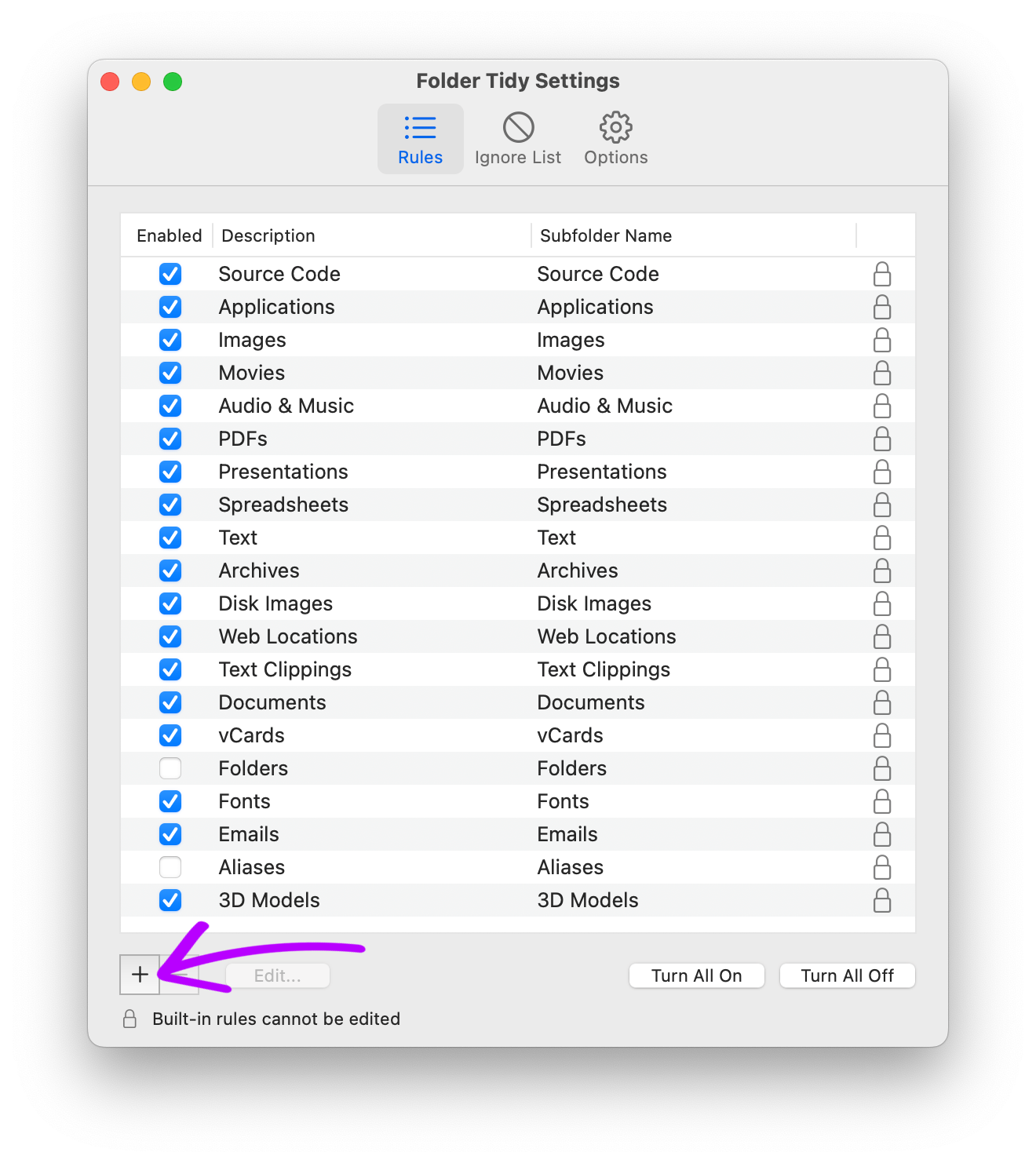
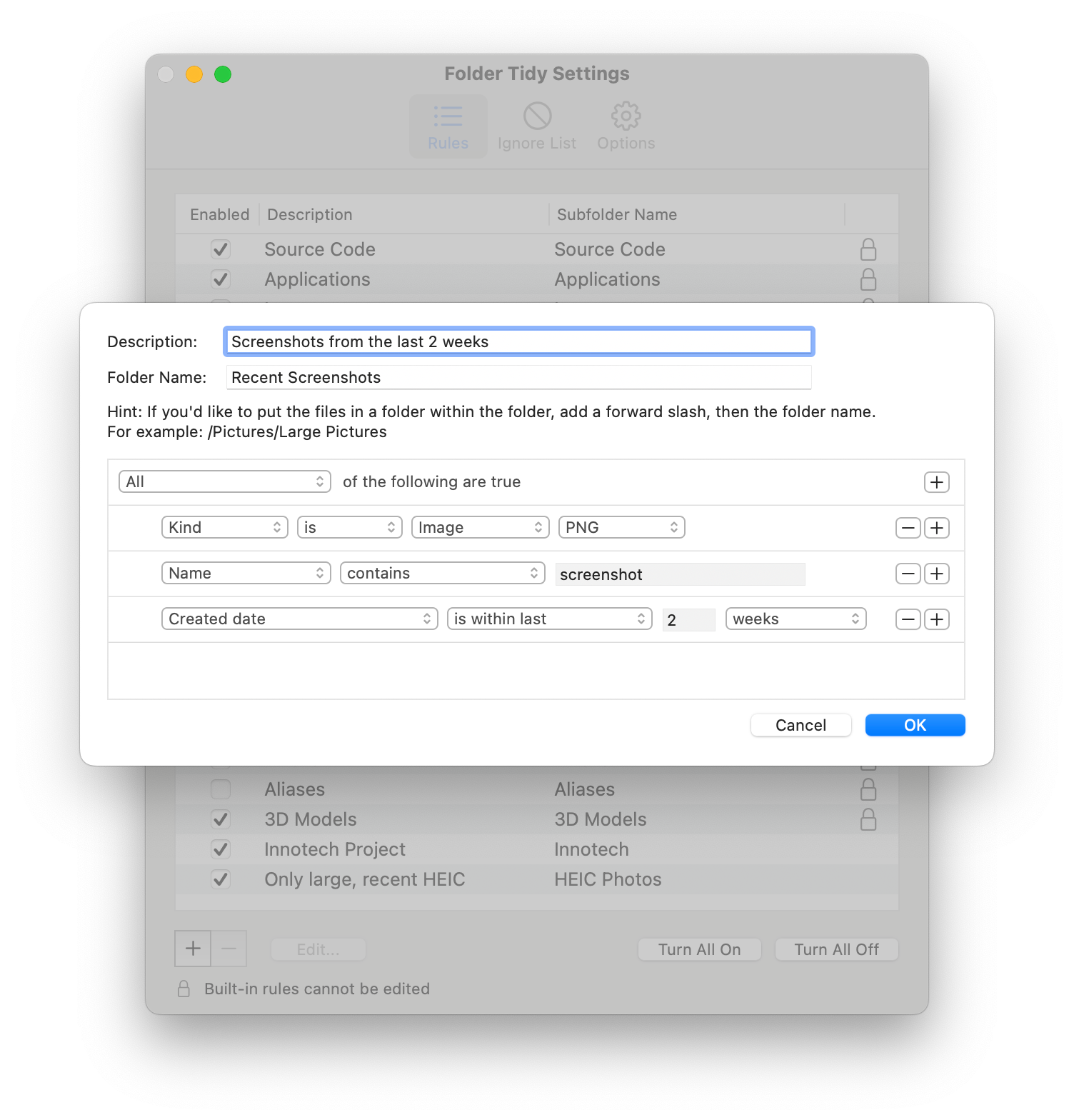
1 - Description: This is what will be displayed for this rule under the Description column with all the other rules.
2 - Folder Name: The name of the folder that will be created to store all the files that match the rule's predicate. It's possible to include multiple folders in this if you'd like to have the files moved to a subfolder. For example, you might want to have multiple rules for photos and they all go to "Tidied Photos", and you'd like this one to go into "Tidied Photos/Vacation" then use that as the folder name.
3 - Rule Editor: This is the main part of a custom rule. The predicates that are created here form the basis of a complete rule. It's very similar to creating a search in Finder. You can combine predicates where all, some or none of them have to be true in order to move a particular file.
In this case, we've created three predicates that must all be true in order to move a file to the "Recent Screenshots" folder: the file must be a PNG picture, it must have the word "screenshot" somewhere in the name and it must be at most 2 weeks (14 days) old.
Performing a tidy
In this example, only one rule has been enabled, which is a custom rule for moving screenshots into a folder named "Recent Screenshots". When running a tidy, any number of built-in and custom rules can be enabled although for simplicity, we'll do just the one here.
Pre-tidy state
Below are screenshots of Folder Tidy and the folder structure before the example tidy is performed.
Folders Chosen
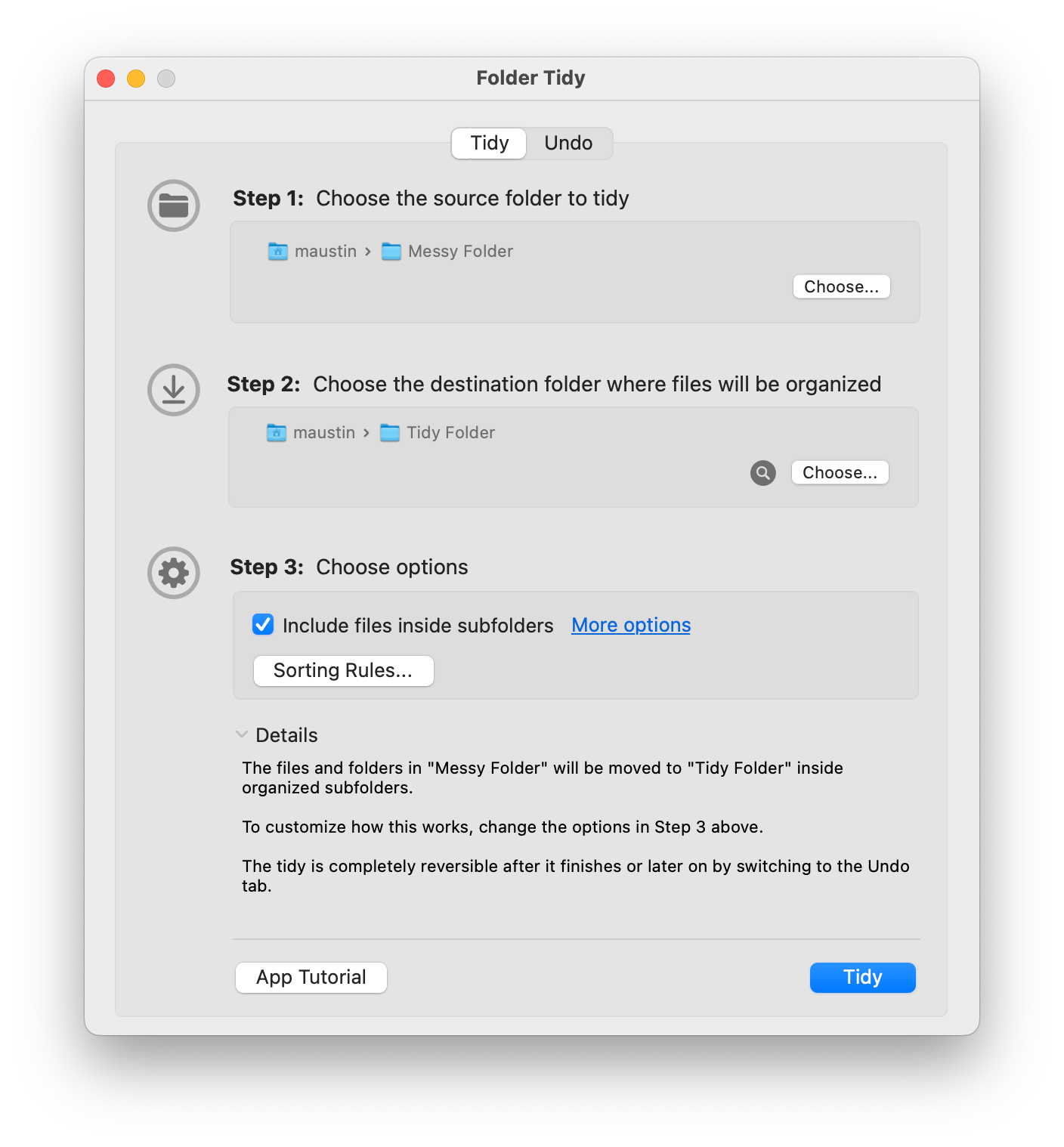
This screenshot shows the main window of Folder Tidy, prepared for the tidy operation. The steps to choose the source folder and destination folder have been finished with both the source (messy) and destination (tidy) folders chosen.
Rules Setup

The settings window displaying the rules available for the tidy operation. In this example, only one rule is enabled to organize recent screenshots into the “Recent Screenshots” folder.
Disorganized Folder Contents

The contents of the “Messy Folder” before the tidy operation. Right now, it's a disorganized collection of files, including various types of documents and screenshots.
Folder Size

The "Messy Folder", which is the folder that will be used to look for the appropriate files that match the rule for recent screenshots, contains over 7,000 items and is just under 2.0GB in size. The entire folder will be searched and the proper files moved into an organized subfolder within just a few seconds.
Post-tidy results
It’s like an incredibly fast magic trick.
Tidy Operation Completed

The tidy operation is now complete. “Messy Folder” has been organized, sorting 71 files in just one second.
Organized Folder
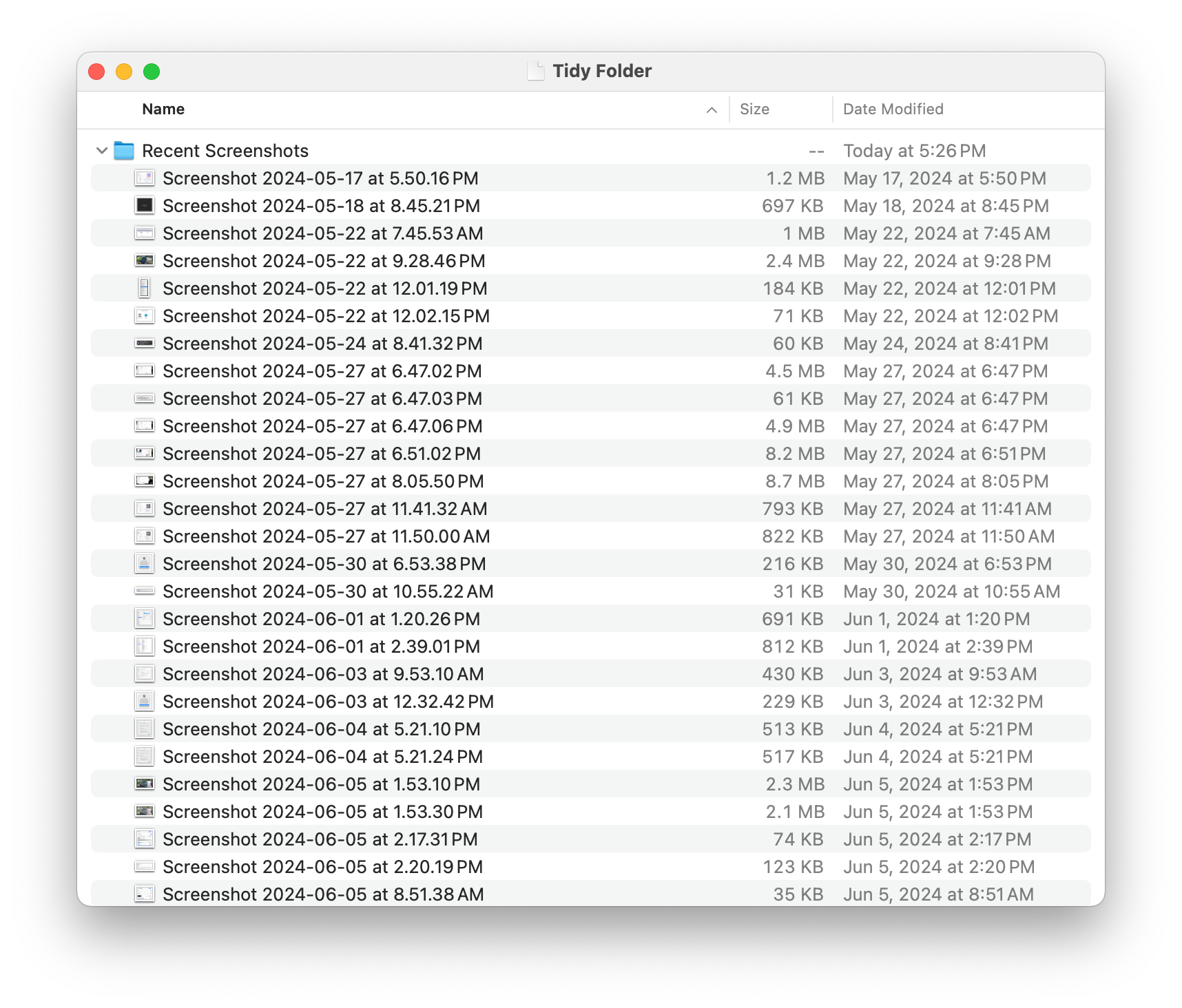
The “Tidy Folder” now contains a new folder labeled “Recent Screenshots” with all 71 files that matched the custom rule neatly organized.
Undoing a Tidy
When an undo is performed, Folder Tidy will process the list of every single file that was moved during that tidy operation and attempt to move them all back to restore the original folder structure. It uses standard macOS file functions and ensures that a file is only removed once the move back has been confirmed as successful without any errors.
Additionally, Folder Tidy will attempt to remove the subfolders it created in the destination folder, provided they are now empty. If there are other files in a folder, it will not be removed.
If the option to remove empty folders in the source folder is enabled, any hidden files or folders within them are backed up as part of the undo process. If the undo is performed, these hidden files and folders are also restored to their original locations. This helps to maintain things like source code version control, folder icon layout, and other hidden settings.
This feature is very useful for experimenting with different rules and options to determine what works best.
It is important to note that if a large number of files are moved back during the undo, the Finder may take some time to update the display of these files in their original folder. Additionally, Spotlight may require some time to reindex the files due to their movement.
Immediate undo
Tidy Completed - Undo Available
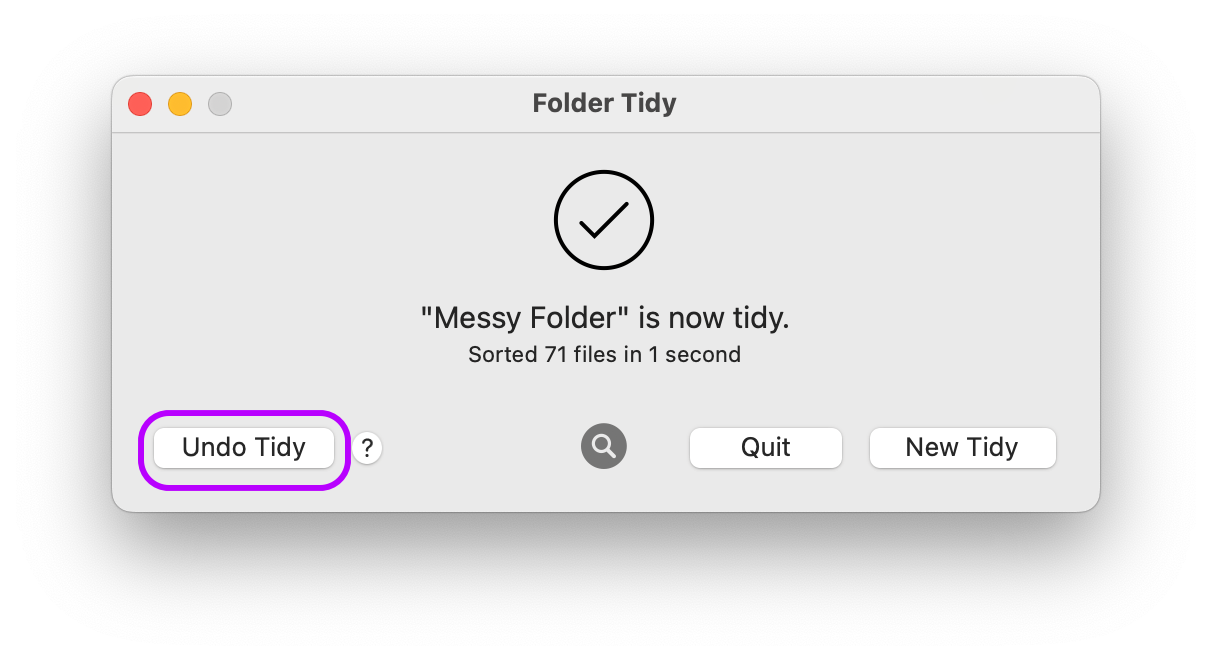
The tidy operation is complete, and the “Undo Tidy” button can be used for immediate restoration of files to their original locations.
Undo Operation Finished
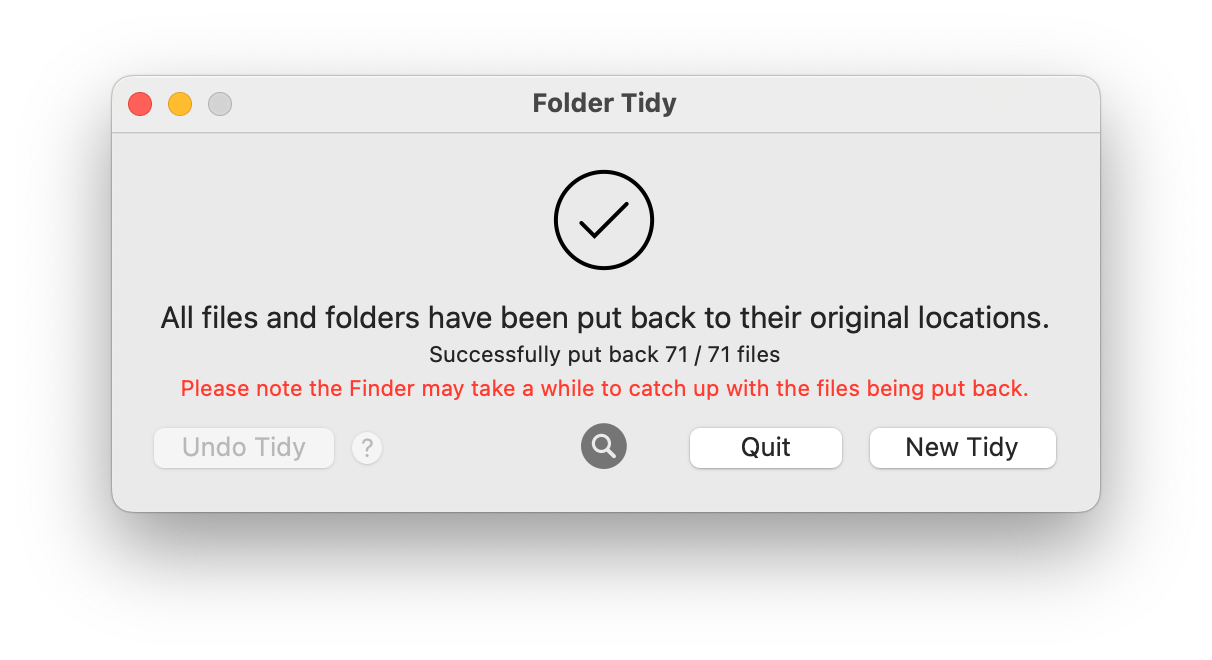
The undo operation has successfully returned all files to their original locations. The Finder may take a moment to reflect these changes.
Undo at a later time
To perform an undo, simply click the “Undo” button.
Any previously completed undos will have a circular checkmark to indicate they were successful.
Available Undo Operations
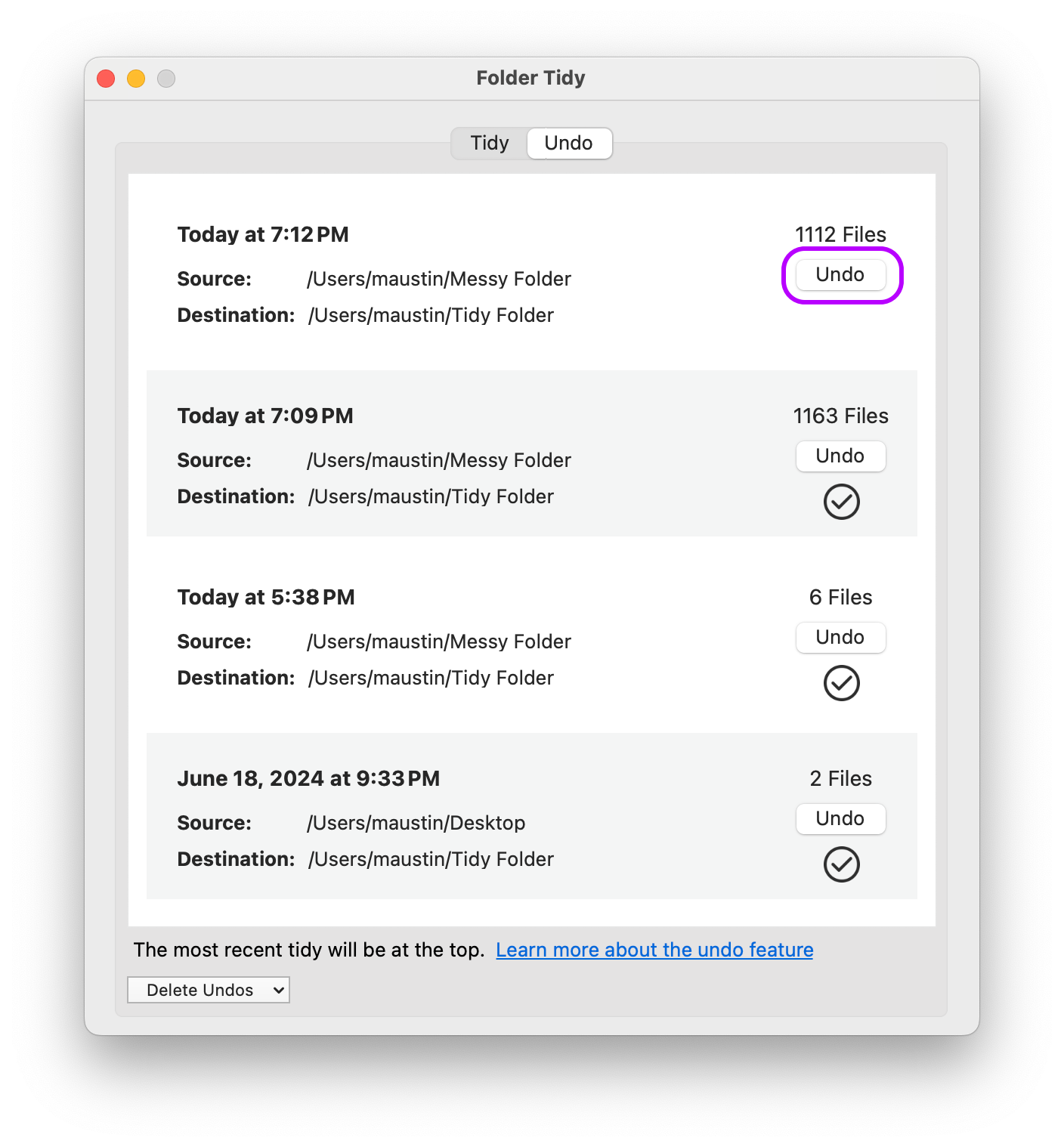
The list of available undo operations is displayed, including details of each tidy operation.
Undo Completed
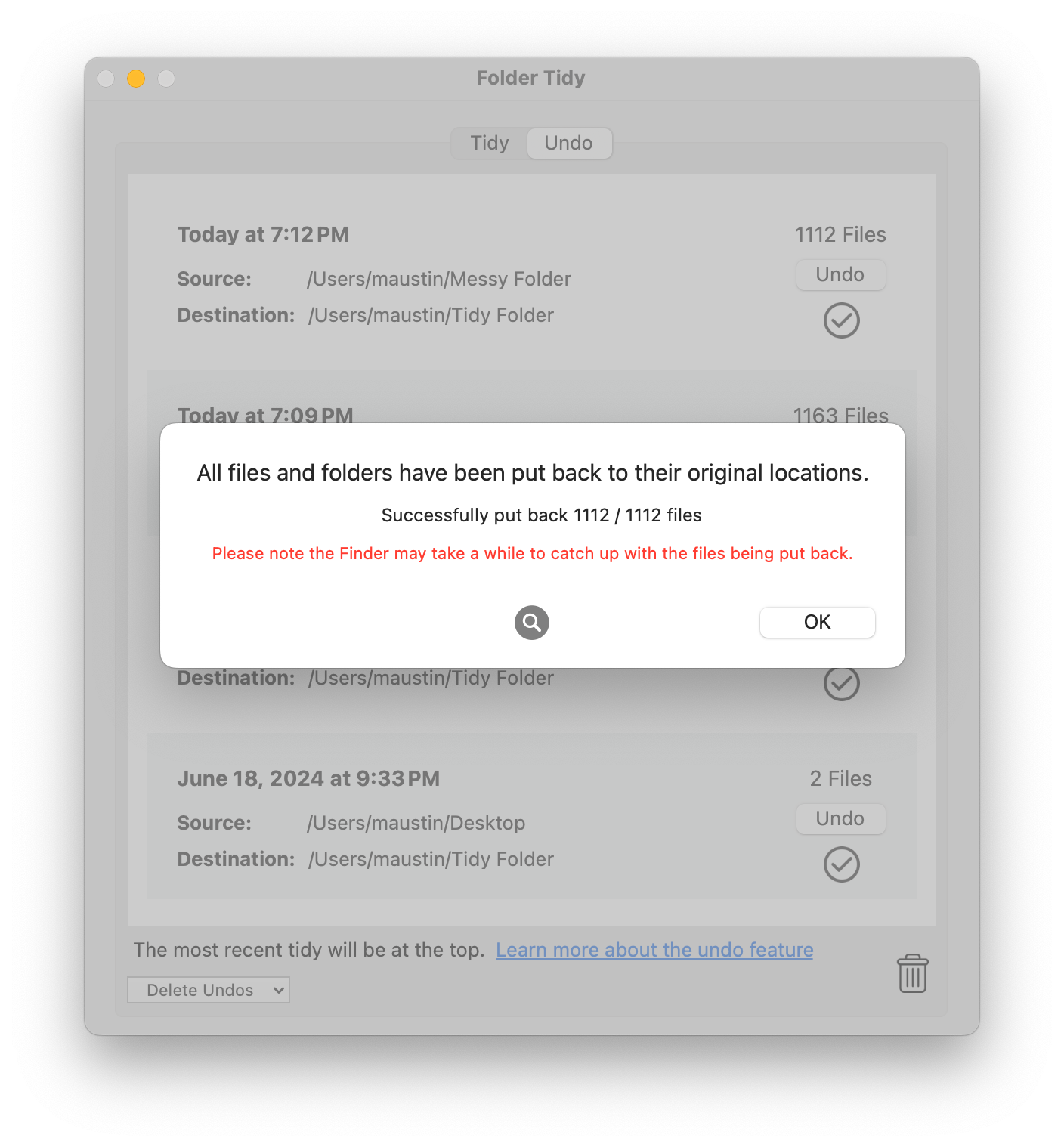
The undo process is initiated and completed, with the restoration of the files to their original locations. The Finder may take a moment to update and reflect these changes.
This will move the undo files to the trash (and not delete them) just in case they are still needed and this was by accident. If you need to restore an undo file that's in the trash, move it to back to the following folder based on which version you have:
Website: /Users/YOUR_USERNAME/Library/Application Support/Folder Tidy/Undos/
App Store: /Users/YOUR_USERNAME/Library/Containers/com.tunabellysoftware.cleanmydesktop/Data/Library/Application Support/Folder Tidy/Undos/
Deleting Specific Undos

To remove specific undos, highlight them in the list and then click the delete button.
Deleting Undos by Age
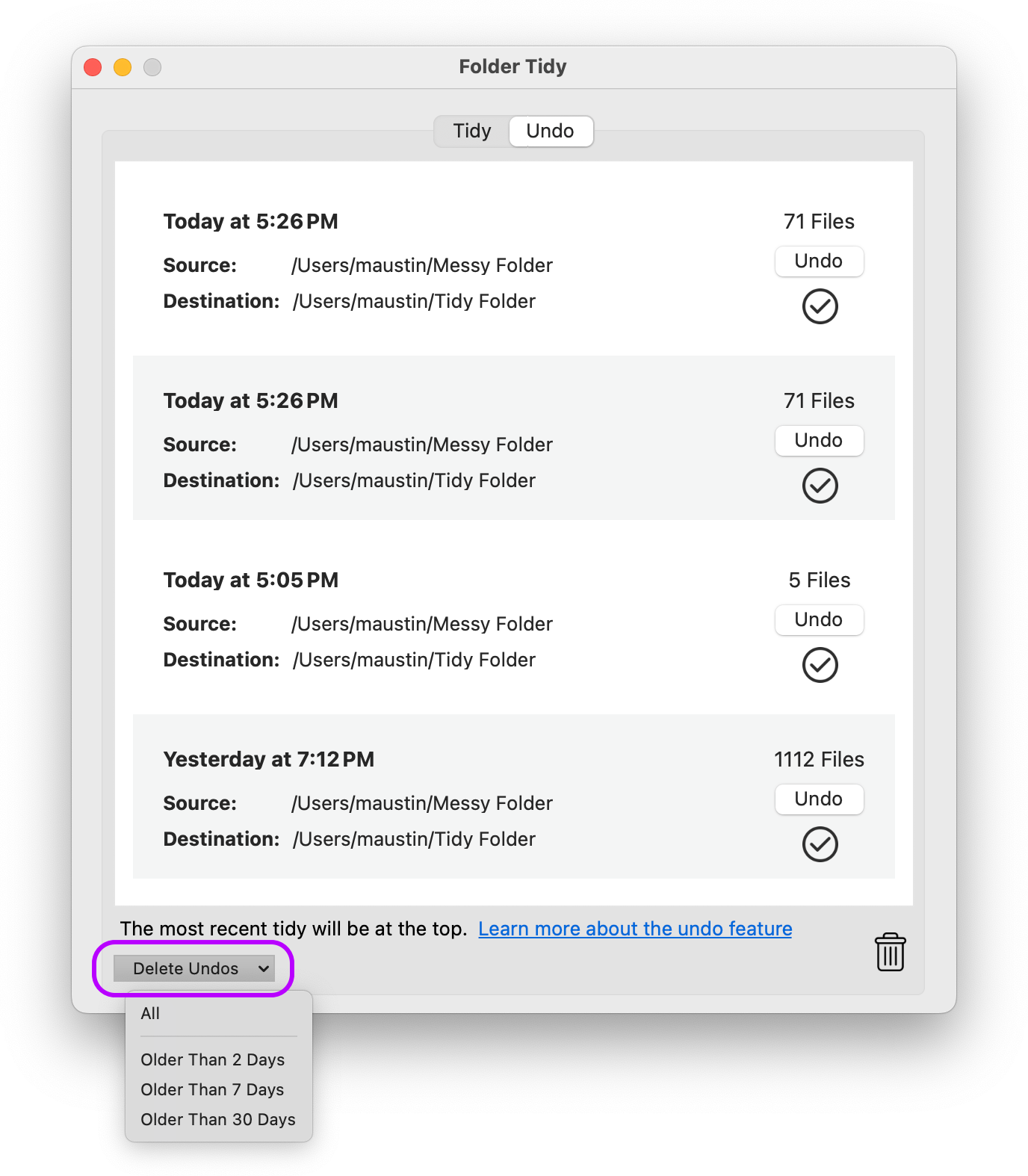
Choose the appropriate duration and all the undos that are older than that age will be removed.
Troubleshooting: No files moved
In this scenario, the number one reason for Folder Tidy being unable to move any files is if the folder they are inside isn't indexed by Spotlight. Folder Tidy uses Spotlight as a reliable and efficient way to determine which files to move since reading the information from each file individually would take an exponentially longer time.
This can usually be from one of two reasons:
1. One of the parent folders is being ignored for indexing by Spotlight. To quickly check if a folder isn't indexed, open the System Preferences, click the Spotlight icon and then the Privacy tab. Make sure the folder or drive isn't included in the list, otherwise Folder Tidy will be unable to tidy any files from those folders.
2. Try rebuilding the Spotlight index on the Mac. It's extremely important to rebuild the index for the entire drive, otherwise it will mot likely not resolve the issue and Folder Tidy will continue to be unable to move any files.
If neither of these help to resolve it, please feel free to email our support team anytime.
Troubleshooting: Retrieving app logs
Enabling Extra Logging
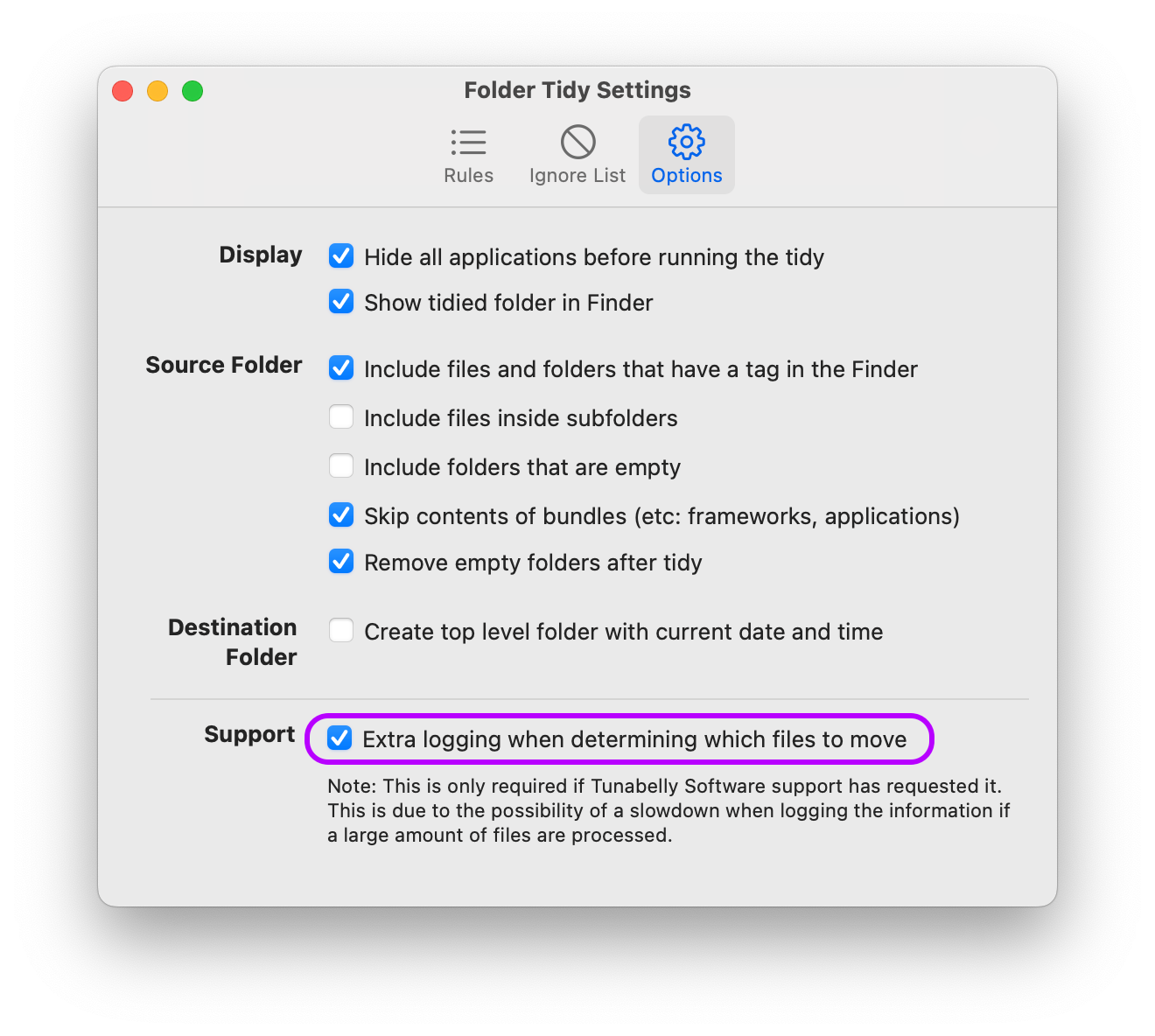
Turning on the option for "Extra logging when determining which files to move" to provide more details on the inner workings of Folder Tidy.
App Log Window

All the output from the app log will be displayed along with a handy button to copy it all to the clipboard for easy pasting.
FAQ
Folder Tidy